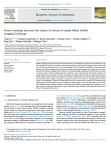Su Y., Lauerwald R., Makowski D., Viovy N., Guilpart N., Zhu P., Gabrielle B., Ciais P. (2025). Future warming increases the chance of success of maize-wheat double cropping in Europe. European Journal of Agronomy, 01/01/2025, vol. 170, p. 127723.
https://doi.org/10.1016/j.eja.2025.127723
https://doi.org/10.1016/j.eja.2025.127723
| Titre : | Future warming increases the chance of success of maize-wheat double cropping in Europe (2025) |
| Auteurs : | Y. Su ; R. Lauerwald ; D. Makowski ; N. Viovy ; N. Guilpart ; P. Zhu ; B. Gabrielle ; P. Ciais |
| Type de document : | Article |
| Dans : | European Journal of Agronomy (vol. 170, 2025) |
| Article en page(s) : | p. 127723 |
| Langues : | Anglais |
| Langues du résumé : | Anglais |
| Catégories : |
Catégories principales 07 - ENVIRONNEMENT ; 7.6 - Changement ClimatiqueThésaurus IAMM CHANGEMENT CLIMATIQUE ; RECHAUFFEMENT GLOBAL ; SYSTEME DE PRODUCTION ; CEREALICULTURE ; BLE ; MAIS ; EUROPE |
| Résumé : | Double cropping can help reduce the risk of food insecurity by harvesting two crops each year instead of one. By increasing the rate of plant development and shortening growing seasons, global warming is likely to favour this type of system in areas where it is not yet being applied. Here we assess the probability of successful implementation of double cropping maize and wheat in Europe under global warming. We compare the caloric productivity of this double cropping system with that of conventional single cropping systems with maize and wheat in rotation, using a hybrid modelling approach combining a process-based model and machine learning. Our results indicate that the decline in caloric productivity of simple maize and wheat cropping systems due to climate change could be offset by the adoption of a double cropping system. By 2100, the area in Europe suitable for successful double cropping is projected to expand by a factor of 3.6, driven by warming under the RCP8.5 scenario. This expansion is expected to significantly boost caloric yield across the continent. In Southern Europe specifically, caloric yield could rise by 29 % compared to single cropping—20 % from maize and 9 % from wheat. These findings provide valuable guidance for policymakers and farmers, positioning double cropping as a strategic solution to safeguard food production while promoting climate adaptation and sustainable agriculture in Europe’s changing agroecosystems. |
| Cote : | En ligne |
| URL / DOI : | https://doi.org/10.1016/j.eja.2025.127723 |







